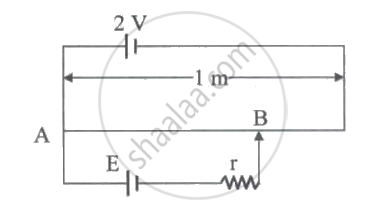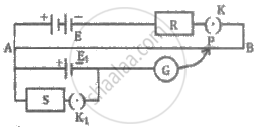Advertisements
Advertisements
प्रश्न
The net resistance of a voltmeter should be large to ensure that ______________ .
विकल्प
it does not get overheated
it does not draw excessive current
it can measure large potential differences
it does not appreciably change the potential difference to be measured
उत्तर
it does not appreciably change the potential difference to be measured
To measure potential difference across any circuit element, the voltmeter is connected in parallel to that circuit element. Let Req be the equivalent resistance of the voltmeter and V be the potential difference across the voltmeter.
Then, the current through the voltmeter, i = \[\frac{V}{R_{eq}}\]
Hence, the deflection in the voltmeter is proportional to the current i and, hence, proportional to V. However, when the voltmeter is used in a circuit, its resistance Req is connected in parallel to some circuit element. This might change the overall resistance of the circuit and, hence, the current. Consequently, the potential difference to be measured is also changed. To minimise the error due to this, the equivalent resistance Req of the voltmeter should be large. When a large resistance is connected in parallel to a small resistance, the equivalent resistance is only slightly less than the smaller one.
APPEARS IN
संबंधित प्रश्न
(i) State the principle on which a potentiometer works. How can a given potentiometer be made more sensitive?

The potentiometer wire AB shown in the figure is 40 cm long. Where should the free end of the galvanometer be connected on AB, so that the galvanometer may show zero deflection?

Draw a labelled circuit diagram of a potentiometer to measure the internal resistance ‘r’ of a cell. Write the working formula (derivation is not required).
Why should not the jockey be slided along the potentiometer wire?
How is potential gradient measured? Explain.
State the uses of a potentiometer.
A battery of emf 4 volt and internal resistance 1 Ω is connected in parallel with another battery of emf 1 V and internal resistance 1 Ω (with their like poles connected together). The combination is used to send current through an external resistance of 2 Ω. Calculate the current through the external resistance.
The resistance of a potentiometer wire is 8 Ω and its length is 8 m. A resistance box and a 2 V battery are connected in series with iL What should be the resistance in the box if it is desired to have a potential drop of 1 µV/mm?
The resistivity of potentiometer wire is 40 × 10-8 ohm - metre and its area of cross-section is 8 × 10-6 m2. If 0.2 ampere current is flowing through the wire, the potential gradient of the wire is ______.
Which of the following is true for a potentiometer?
A cell of e.m.f. 'E' is connected across a resistance 'R'. The potential difference across the terminals of the cell is 90% ofE. The internal resistance of the cell is ______.
A potentiometer wire is 10 m long and has resistance of 2`Omega`/m. It is connected in series with a battery of e.m.f 3 V and a resistance of 10 `Omega`. The potential gradient along the wire in V/m is ______.
In the given figure, battery E is balanced on 55 cm length of potentiometer wire but when a resistance of 10 `Omega` is connected in parallel with the battery, then it balances on 50 cm length of the potentiometer wire. The internal resistance r of the battery is ____________.

A wire has a length of 2m and a resistance of 10Ω. It is connected in series with a resistance of 990Ω and a cell of e.m.f. 2V. The potential gradient along the wire will be ______
Two students X and Y perform potentiometer experiment separately and null point was obtained as shown in diagram. During the experiment, ______.
- X increases the value of R (resistance)
- Y decreases the value of S (resistance)
The position of null point obtained by students X and Y respectively.

In a potentiometer experiment when three cells A, B, C are connected in series the balancing length is found to be 740 cm. If A and B are connected in series, the balancing length is 440 cm and when B and C are connected in series, it is 540 cm. The e.m.f. of A, B, and C cells EA, EB, EC are respectively (in volt) ______
In the experiment of potentiometer, at balance point, there is no current in the ______.
In a potentiometer circuit a cell of EMF 1.5 V gives balance point at 36 cm length of wire. If another cell of EMF 2.5 V replaces the first cell, then at what length of the wire, the balance point occurs?
Draw neat labelled diagram of potentiometer as voltage divider.
